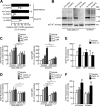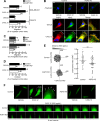Aquaporin-3 Controls Breast Cancer Cell Migration by Regulating Hydrogen Peroxide Transport and Its Downstream Cell Signaling
- PMID: 26830227
- PMCID: PMC4800788
- DOI: 10.1128/MCB.00971-15
Aquaporin-3 Controls Breast Cancer Cell Migration by Regulating Hydrogen Peroxide Transport and Its Downstream Cell Signaling
Abstract
Most breast cancer mortality is due to clinical relapse associated with metastasis. CXCL12/CXCR4-dependent cell migration is a critical process in breast cancer progression; however, its underlying mechanism remains to be elucidated. Here, we show that the water/glycerol channel protein aquaporin-3 (AQP3) is required for CXCL12/CXCR4-dependent breast cancer cell migration through a mechanism involving its hydrogen peroxide (H2O2) transport function. Extracellular H2O2, produced by CXCL12-activated membrane NADPH oxidase 2 (Nox2), was transported into breast cancer cells via AQP3. Transient H2O2 accumulation was observed around the membrane during CXCL12-induced migration, which may be facilitated by the association of AQP3 with Nox2. Intracellular H2O2 then oxidized PTEN and protein tyrosine phosphatase 1B (PTP1B) followed by activation of the Akt pathway. This contributed to directional cell migration. The expression level of AQP3 in breast cancer cells was related to their migration ability both in vitro and in vivo through CXCL12/CXCR4- or H2O2-dependent pathways. Coincidentally, spontaneous metastasis of orthotopic xenografts to the lung was reduced upon AQP3 knockdown. These findings underscore the importance of AQP3-transported H2O2 in CXCL12/CXCR4-dependent signaling and migration in breast cancer cells and suggest that AQP3 has potential as a therapeutic target for breast cancer.
Copyright © 2016, American Society for Microbiology. All Rights Reserved.
Figures







Similar articles
-
Involvement of aquaporin-3 in epidermal growth factor receptor signaling via hydrogen peroxide transport in cancer cells.Biochem Biophys Res Commun. 2016 Mar 18;471(4):603-9. doi: 10.1016/j.bbrc.2016.02.010. Epub 2016 Feb 16. Biochem Biophys Res Commun. 2016. PMID: 26896765
-
Aquaporin-3-mediated hydrogen peroxide transport is required for NF-κB signalling in keratinocytes and development of psoriasis.Nat Commun. 2015 Jun 23;6:7454. doi: 10.1038/ncomms8454. Nat Commun. 2015. PMID: 26100668 Free PMC article.
-
PTP1B promotes aggressiveness of breast cancer cells by regulating PTEN but not EMT.Tumour Biol. 2016 Oct;37(10):13479-13487. doi: 10.1007/s13277-016-5245-1. Epub 2016 Jul 27. Tumour Biol. 2016. PMID: 27465552
-
Aquaporin-3 in Cancer.Int J Mol Sci. 2017 Oct 7;18(10):2106. doi: 10.3390/ijms18102106. Int J Mol Sci. 2017. PMID: 28991174 Free PMC article. Review.
-
Intracellular messenger function of hydrogen peroxide and its regulation by peroxiredoxins.Curr Opin Cell Biol. 2005 Apr;17(2):183-9. doi: 10.1016/j.ceb.2005.02.004. Curr Opin Cell Biol. 2005. PMID: 15780595 Review.
Cited by
-
AQP3 and AQP5 Modulation in Response to Prolonged Oxidative Stress in Breast Cancer Cell Lines.Antioxidants (Basel). 2024 May 21;13(6):626. doi: 10.3390/antiox13060626. Antioxidants (Basel). 2024. PMID: 38929065 Free PMC article.
-
The Involvement of Peroxiporins and Antioxidant Transcription Factors in Breast Cancer Therapy Resistance.Cancers (Basel). 2023 Dec 8;15(24):5747. doi: 10.3390/cancers15245747. Cancers (Basel). 2023. PMID: 38136293 Free PMC article. Review.
-
Polyacrylic-Coated Solid Nanoparticles Increase the Aquaporin Permeability to Hydrogen Peroxide.Int J Mol Sci. 2023 Dec 27;25(1):372. doi: 10.3390/ijms25010372. Int J Mol Sci. 2023. PMID: 38203543 Free PMC article.
-
ROS from Physical Plasmas: Redox Chemistry for Biomedical Therapy.Oxid Med Cell Longev. 2019 Oct 8;2019:9062098. doi: 10.1155/2019/9062098. eCollection 2019. Oxid Med Cell Longev. 2019. PMID: 31687089 Free PMC article. Review.
-
SP1-Induced Upregulation of lncRNA LINC00659 Promotes Tumour Progression in Gastric Cancer by Regulating miR-370/AQP3 Axis.Front Endocrinol (Lausanne). 2022 Jul 26;13:936037. doi: 10.3389/fendo.2022.936037. eCollection 2022. Front Endocrinol (Lausanne). 2022. PMID: 35957833 Free PMC article.
References
Publication types
MeSH terms
Substances
LinkOut - more resources
Full Text Sources
Other Literature Sources
Medical
Research Materials
Miscellaneous
